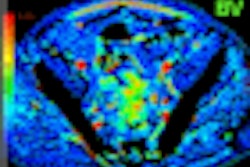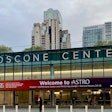CHICAGO - Is a two-day dose of accelerated partial-breast irradiation (APBI) effective in the long term for patients with early-stage breast cancer? Does it represent a radical treatment improvement as well as offering the potential to slash radiation treatment costs?
A report presented on Monday at the RSNA annual meeting on the short-term outcomes of patients who received a two-day treatment course with a MammoSite (Hologic, Bedford, MA) balloon applicator evoked both concern and enthusiasm among session attendees.
Michelle Wallace, a radiation oncology nurse clinician at William Beaumont Hospital in Royal Oak, MI, where this prospective, phase II, nonrandomized trial is being conducted, reported that this pioneering APBI treatment is safe and well tolerated by a patient cohort of 45 women. With the exception of seroma, grade 2/3 chronic toxicity rates have been less than 10%, and cosmesis has been good to excellent in 96% of the patients.
The existing track record of safety and success of five-day APBI treatments, with 99% local control being reported at five years, led oncology researchers at William Beaumont Hospital to initiate a clinical trial to determine if fraction sensitivity of breast cancer can be further exploited with higher radiation doses and more compressed treatment time.
Forty-five women who had breast-conservation surgery for early-stage breast cancer (ductal carcinoma in situ, stages I and II) were enrolled in the trial between March 2004 and August 2007. The selection was limited to women 40 years of age and older. The cohort ultimately ranged in age from 48 to 83 years, with a median age of 66. Other eligibility requirements included having tumors smaller than 3 cm, negative margins, and no more than three pathologically positive lymph nodes.
Participants in the trial also were required to have a minimum of 8 cm skin to balloon spacing. A MammoSite device was used to deliver four 7Gy fractions of APBI in 48 hours, for a total of 28 Gy. The treatment was delivered 1 cm beyond the balloon surface. Treatment intervals were at least six hours apart.
Follow-up is ongoing, Wallace emphasized, but the findings she presented were based on a median follow-up period of 11.4 months, representing 47% of the cohort. Twenty-nine percent of the patients had treatment between one and two years previously, 7% between two and three years, and one patient between three and four years.
Two patients acquired infections that were verified with a positive culture. Breast pain in 13% of the patients was the predominant toxicity identified within six months of treatment, and it was the only toxicity reported as both grade 2 and 3. Nine percent of the patients had grade 2 radiation dermatitis, and grade 2 breast edema, hyperpigmentation, and telangiectasia were each identified in 2% of the total cohort.
However, after six months, only 2% of the patients had grade 2 radiation dermatitis, and 2% had induration.
Seroma was identified in thirteen, or 30%, of the patients, Wallace reported. Other symptoms of late toxicity included four patients who developed fat necrosis and two patients who had rib fractures.
"We were very pleased with the cosmesis outcome of these patients," Wallace said. "Cosmesis was good to excellent for 96% of the patients. By comparison, five-day MammoSite treatment averages 83.3% based on published studies, and interstitial brachytherapy averages 95%."
"None of the patients have had local recurrence. However, further follow-up is needed to establish both the safety and efficacy of this treatment approach. We caution that patients treated with these aggressive fractionation schedules should only be studied on carefully designed and monitored research trials," Wallace emphasized.
One session attendee expressed concern that the success of no local recurrence might change with future follow-up: "I think that you are going to have to wait another three to four years to see your results before you can report with certainty that this is an effective treatment."
Concern was also expressed about the two patients who had rib fractures and pain. One attendee stated, "This represents approximately 5% of your cohort. If this were a trial I was conducting, I would find this to be an unacceptable toxicity level. The fact that your cohort is small may also not accurately represent toxicity levels."
Another attendee suggested that if this treatment protocol were adopted by radiation oncologists, patient selection would have to be very carefully defined, and he said that he might limit the treatment only to patients with large breasts.
Wallace agreed with the comment that the toxicities reported for 45 women might change with a larger patient cohort, but said that the trial was specifically limited to a small number of patients for safety reasons.
Dr. Robert Kruske, clinical professor of the University of Arizona Health Sciences Center in Tucson and a radiation oncologist at Arizona Oncology Services, another presenter at the session, commented that this type of treatment might be ideal for early-stage breast cancer patients who need to travel great distances and would like to receive their treatment rapidly. "I have Native American patients who come for treatment from very remote locations. This could be quite beneficial for them."
Utilization with elderly patients for whom travel or transportation might be difficult was also suggested. Wallace pointed out that the cohort included at least one such patient.
Another session attendee raised the question of treatment cost, and noted that a two-day MammoSite treatment program would probably be financially detrimental to a cancer center and possibly even an outright loss. Wallace agreed with this, but said that hospitals needed to accept and understand the financial situations of their patients.
Agreeing with Wallace, a session attendee added that some patients would opt to choose a less expensive, shorter duration treatment with a higher potential local recurrence risk than a treatment that could place a huge financial burden on them, and potentially be detrimental to their quality of life. He pointed out that while this is not specific to a trial, if two-day APBI treatment becomes widely adopted but eventually proves riskier than five-day APBI, such a scenario might be very real.
Kruske also pointed out that the 2009 Medicare reimbursement rates were cutting brachytherapy treatment by 50%, and that cancer centers needed to accept the reality of reduced reimbursements for cancer treatments in future years.
Dr. Manjeet Chadha, associate chairman of the Department of Radiation Oncology at Beth Israel Medical Center and associate professor at Albert Einstein College of Medicine in New York City, another session presenter, emphasized that it will become the responsibility of oncologists to personalize patient treatment. She noted that just as breast cancer treatment is becoming individualized, in the near future it may be personalized as well. "What we think is best clinically for the patient may not be best for them," she said. "An almost-as-good treatment option may actually be better."
This extended discussion was possible due to the fact that five of the nine session presenters failed to appear, perhaps setting a new precedent at an RSNA meeting. However, full advantage was taken of the opportunity for extended discussion of the topics that were presented.
By Cynthia Keen
AuntMinnie.com staff writer
December 2, 2008
Related Reading
Study: APBI compares favorably to standard RT, October 1, 2008
Accelerated radiation schedule effective, convenient for early breast cancer, September 23, 2008
Accelerated breast radiotherapy leads to less toxicity, radiation exposure, September 10, 2007
Copyright © 2008 AuntMinnie.com



















